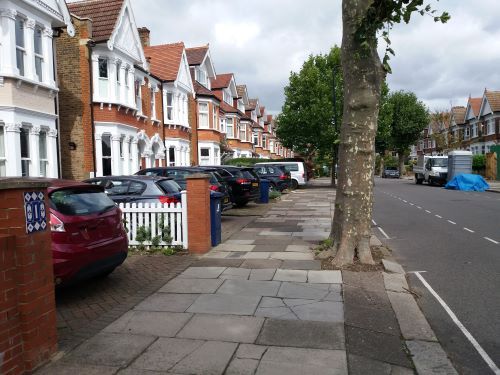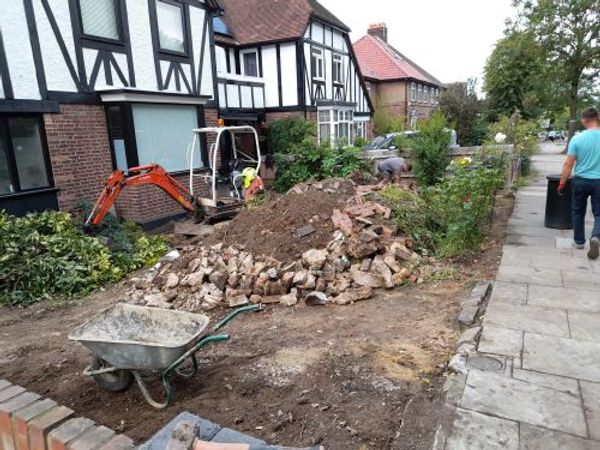
The crazy world of front garden regulation
The rush to cover front gardens in concrete started in 1995 when the government allowed householders to ‘cross over’ the pavement to park on front gardens, if they had one.
That simple change in planning regulations kick-started the rapid conversion of the nation’s front gardens into car parks (for more on exactly what happened, see below).
Uptake was particularly rapid in urban areas, where many wanted the comfort and convenience of seeing and getting to a car parked right outside. Some local authorities supported it in the mistaken belief that removing parked cars from residential roads would ease congestion.
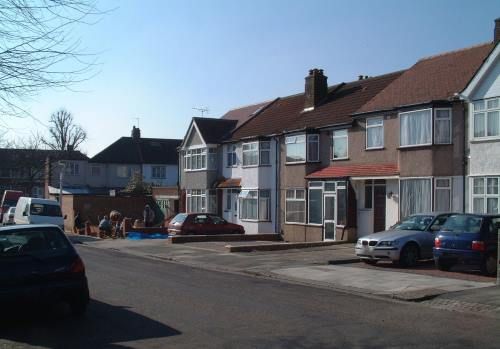
But these very towns and cities are also vulnerable to flood risk and harmful high heat, as has been seen in recent years. Losing so much soil, grass and garden space on so many streets is also not great for nature on our doorsteps (see our earlier blog).
Waking up to the problem
Some important bodies concerned with looking ahead to what’s needed to make the nation more resilient to flood, heat and other effect of a changing climate, now seem to understand that some of the problems they are trying to address are being directly undermined by the rising tide of paved-over front gardens.
In the past few years, august bodies saying front garden loss is increasingly on their radar include:
- The UK Climate Change Committee: the government’s advisers on what’s needed to avoid climate chaos has been flagging concerns about paving front gardens since at least 2012. Over a decade later in March 2024 the UKCCC said “The evidence of the damage from climate change has never been clearer, but the UK’s current approach to adaptation is not working”, and in interviews Baroness Brown, Chair of the CCC’s Adaptation Committee, specifically mentioned the damaging paving over of gardens.
- The National Infrastructure Commission: the NIC is charged with thinking ahead about the nation’s transport, energy and other infrastructure. In November 2022 it identified paved-over front gardens as a surface water flood risk. (But it rather misunderstood the problem by suggesting that local councils could act when they lack the power to do so – see below for more on council powers).
- Ofwat: the government’s regulator of private water companies suggested in March 2023 that water companies could try “reducing bills for homes with water butts and permeable driveways which can help to reduce risk of flooding and pollution to rivers and bathing water”.
Now that these and other bodies are alive to how losing front gardens to hard surfacing is undermining efforts to protect life, limb and assets, central government must listen and act. (Since this blog was published, the Government has accepted the NIC's recommendations and DEFRA will review the impacts and opportunities to manage surface water flood risk, reporting by end 2024).
How did it come to this?
Thirty years ago, London’s green front gardens were part of its lungs and sponge – oxygenating the air and soaking up rainwater. Now they’re adding to surface water flooding and sewage discharges, overheating, biodiversity and habitat loss, subsidence and pollution – and leaving local authorities, water companies and transport infrastructure to pick up the pieces.
In 1995 John Major’s Conservative Government designated pavement crossovers as permitted development. Article 3 of the Town & Country Planning (General Permitted Development) Order 1995 allowed householders to “cross over” the pavement and park in their front gardens. This began a rapid conversion of the nation’s front gardens into car parks. Entire front gardens were swiftly covered in concrete.

In response to extensive flooding in several English cities in 2007, Gordon Brown’s Labour Government rushed through the Town and Country Planning (General Permitted Development) (Amendment) (No. 2) (England) Order 2008. It requires front garden hard surfacing of more than five square metres in area “to either be made of porous material or, if an impermeable surface, to direct runoff to a soakaway area or rainwater storage within the property’s boundary”.
This means householders can still pave or concrete the entire front garden, as long as there is some provision for runoff.

In practice, these run-off requirements are often disregarded by contractors, or poorly maintained by householders. The end result is that, as shown in previous blogs, many front gardens paved since 2008 just can’t cope in the increasingly heavy downpours we’re now experiencing. Those paved before 2008 have no run-off provision at all. In both, rain runs off into the road drains. This can often lead to local surface water flooding and sewage discharge into rivers.
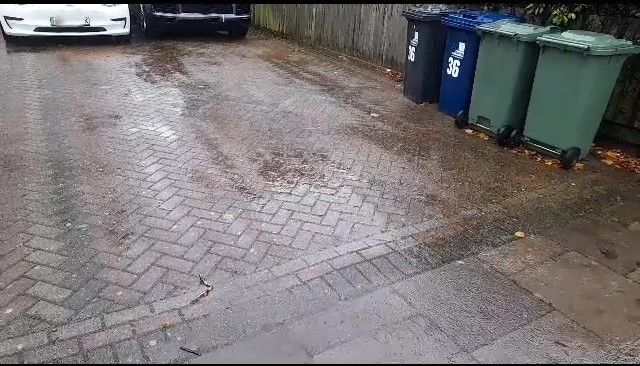
In 2011, researchers at the London Wildlife Trust, GIGL and the GLA estimated that about 63 percent of the total area of front gardens in Greater London was hard surfaced (report). It’s likely to be at least 75 percent now. And it’s increasing remorselessly.
Home charging
Much of this is due to people charging their electric vehicles at home. Lower VAT rates and overnight charging deals make home charging much cheaper than using a roadside device. This serves as a push factor for householders to want to park their electric cars in the front garden wherever possible. Until recently, the Government was actively encouraging this with its Electric Vehicle Homecharge Scheme grants.
Result? More applications for pavement crossovers AND more householders extending their existing front garden parking by taking out hedges and flower beds, so all the household’s vehicles can be accommodated. All entirely predictable (see our earlier blog).
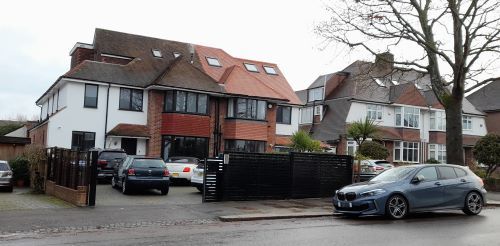
Who has control?
Local councils, communities and others all bear the consequences of this growing loss of front gardens but there is very little anyone, apart from the Government, can do about it.
Local authorities have to approve most applications for crossovers under the government’s Permitted Development rules. Grounds for refusal are few: safety if too close to a road junction or bus stop; if a lamppost, tree or other street furniture is in the way; if the front garden is considered too small; if an Article 4 Direction applies or if the amount of on-street parking would be unacceptably reduced. The last two can be legally problematic.
In London, each borough has its own criteria. These can be changed. In early 2024, in response to pressure from residents for home charging, Richmond upon Thames reduced its minimum garden size for crossover application by 83%. This will obviously result in many more paved-over front gardens throughout the borough – with all the resulting problems the Council itself will have to face. The situation is increasingly untenable.
Some boroughs are trying to discourage crossover applications by tightening up their criteria, increasing crossover application and installation charges, and highlighting flood and subsidence risks. Some try to clamp down on crossovers illegally constructed without permission. Some are trying to include statements about better and smaller front garden parking surfaces in their Local Plans, and front gardens’ importance in responding to the threats of climate change (heat and flooding) and biodiversity loss.
But realistically there’s very little local authorities can do on their own to stem the tide of front garden paving and parking. So, they are focussing on what they can do to counteract the problem.

Many are working on greening roadsides where they have control as Highway Authorities. They are installing rain gardens, greening verges and crossovers, depaving, creating parklets, planting more trees and putting in sustainable urban drainage (SuDS) – another area the government has resisted or been slow to act.

Who’s paying?
Since serious flooding in 2021 in London, reducing flood risk is particularly high up the agenda. Many SuDS and greening projects are being funded by Thames Water and by the Mayor of London. Transport for London is also working on greening its roadsides, and its rail and tube routes and estate.
But ultimately, it’s the taxpayer footing the bill, though council tax, water bills and passenger fares. And it’s expensive: as one of Camden Council’s officers said at a GLA Environment Committee meeting in January 2024:
“Highways, while capital expensive, are very cheap on the revenue side. Green space is the exact opposite. It may be quite cheap on the capital side, but it does cost a lot of money to keep it tidy, to keep it clean and to make sure it is giving us the value that we are all seeking from it.”
Time to act
Important bodies have now clocked how losing the role of front gardens makes no sense. As advisers to central government, they could help by persuading it to change the planning rules which are clearly outmoded and no longer fit for purpose.
Yet here we are – householders are still paving over their front gardens with impunity, rainwater is running off, good work to make neighbourhoods resilient is being undermined and major problems with climate resilience and biodiversity are being worsened, all for the sake of parking and charging vehicles on front gardens.
The public as a whole is having to pay for costly palliatives, and the only organisation with real power to improve the situation is the one which isn’t doing anything – the Government.
